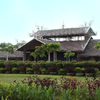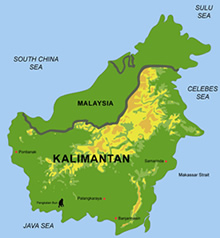remote sensing

our work
kalteng remote sensing shows trends in environments like Kalimantan.
- TanDEM-X elevation model data for canopy height ...
- Monitoring Forest Threats with C- and L-band SAR, ...
- Ground Penetrating Radar Mapping of Peat ...
- Spectral Variability and Discrimination ...
- Kalteng Consultants Company Profile, Oct
- Visiting of Wetlands International Camp on ...
- Ortho Photo Mosaik von Kelurahan Tumbang Tahai ...
- Ortho-Photo Mosaik from Lake Batu, north of ...
- International Symposium & Workshop on Tropical ...
- The Contribution of CHRIS/PROBA Data for Tropical ...
- Workshop on Spatial Planning and new Remote ...
- Ortho-Photo Generation and Mosaiking of City ...
- Ortho-Photo Mosaik from Kecamatan Bukit Batu, ...
- International Workshop, Wild Fire and Carbon ...
- Planning Group for Kecamatan Bukit Batu gathered ...
- Carbon Storage in the Northern Sabangau Area ...
- Peat Land Topography derived from 30m Resolution ...
- Peat depth, minerals below peat, carbon, fires ...
- Carbon Storage in the Northern Sebangau Area ...
- Peatland Topography DEM-measurements with ...
- Precise Measurements of Peatland Topography and ...
- Environmental Management Study of the Tangkiling ...
- Environmental Field Trials and GIS Image ...
- Land Cover Change on Peatland in Kalimantan ...
- The Impact of Logging and Land Use Change in ...
- Tracks along the Kalimantan Highway from Kasongan ...
- Fires in 2002 monitored on the Landsat-images 14 ...
- The Amount of Carbon released from Peat and ...
- Land use Change in Central Kalimantan over the ...
- Remote Sensing and Aerial Survey of Vegetation ...
- Monitoring land cover and impacts, Remote Sensing ...
- Fire Impacts and Carbon Release on Tropical ...
- Ecological Impact of the one Million Hectare Rice ...
- Land Use Change and (Il)-Legal Logging in Central ...
- Peat fires in Central Kalimantan, Indonesia: Fire ...
- Environmental Helicopter Flight Trails with ...
- Impact of the 1997 Fires on the Peatlands of ...
- Application of Remote Sensing and GIS to monitor ...
- Monitoring of 1997/1998 Fires and Burnt Scars in ...
- Flight survey over the Mega Rice Project and over ...
- Application of Remote Sensing and GIS to survey ...
- Mega Rice Project in Central Kalimantan, ...
- Satellite Images and Aerial Photos from the ...
- The need for better
- Remote Sensing Verification by Aerial Surveys and ...
- NATURAL RESOURCE FUNCTIONS, BIODIVERSITY AND ...
- Excursion to Central Kalimantan, ...
- Satellite Images and Aerial Photography’s from ...
- Symposium of International Peat Society, ...
- Indonesia Travel to Jakarta, Bali and Kalimantan ...
- The Mega Rice Project Central Kalimantan ...
- Land Use Planning and Environmental Monitoring in ...
- Bildverarbeitung von Sensorbildern zur Erstellung ...
- GIS-Workshop, Camp km48 Sangai.
- Monitoring Land Use Change on Tropical Peatland ...
- Seminar on Scientific Implications of the ...
- Report of Ground Truth Campaigns incl. Aerial ...
- Ground and Helicopter verification of Satellite ...
- Environmental Detection from Satellite and ...
- First visit to Central Kalimantan in June 1995, ...
- Environmental Helicopter with Modular Sensor ...
- Remote Sensing with a Thermal Imager on an ...
- The Use of an Environmental Helicopter for the ...
- EUROMAR-SEASTARS a Modular Multi-Sensor System ...
gallery

image gallery
Find a large collection of images from many years of exploration by kalteng-consultants.
History Borneo - Kalimantan · Excursions to peatland 1996 · Mega Rice Project 1999 · 2004 · 2005 · 2006 · 2007 · 2008 · 2009 · 2010 · 2011 · 2012 · 2013 · 2014 · 2015 · 2016-March · 2016-August ·
remote sensing
Ecological Impact of the one Million Hectare Rice Project in Central Kalimantan, using Remote Sensing and GIS, 11-2001
presented at
22nd Asian Conference on Remote Sensing (ACRS),
5-9 November 2001, Singapore
kalteng_2001-126BoehmA-ACRS.pdf
by
Boehm, H.-D.V. (1), Siegert, F. (1,2)
22nd Asian Conference on Remote Sensing (ACRS),
5-9 November 2001, Singapore
kalteng_2001-126BoehmA-ACRS.pdf
by
Boehm, H.-D.V. (1), Siegert, F. (1,2)
1) Kalteng Consultants, Kirchstockacher Weg, 85635 Hoehenkirchen near Munich, Germany.
Tel: +49 8102 774848, Fax: +49 8102 774850, e-mail: viktorboehm@t-online.de
2) Remote Sensing Solutions GmbH, Woerthstrasse 49, D-81667 Munich, Germany
Tel: +49 89 48954765, Fax: +49 89 48954767, e-mail: siegert@rssgmbh.de
Tel: +49 8102 774848, Fax: +49 8102 774850, e-mail: viktorboehm@t-online.de
2) Remote Sensing Solutions GmbH, Woerthstrasse 49, D-81667 Munich, Germany
Tel: +49 89 48954765, Fax: +49 89 48954767, e-mail: siegert@rssgmbh.de

Aerial photos of the Mege Rice Project Channels
Abstract
The province of Central Kalimantan contains about three million hectares of peatland, which is one of the largest unbroken tropical peatland areas in the world. Peat swamp forest (PSF) is among the earth's most endangered and least known ecosystem (12). They have a huge carbon storage capacity and are extremely fragile and liable to disturbance (10). Local communities have used them extensively for centuries with no significant effect on the environment. This changed in 1996 when a programme of massive peatland conversion, the so-called Mega Rice Project (MRP), was initiated with the aim of converting one million hectares of peatland into rice fields. Between January 1996 and July 1998 more than 4000km of drainage and irrigation channels were constructed in the area designated for the MRP (9). Many people were able to access the previously inaccessible interior of this peatland landscape to exploit the residual timber resources, mostly doing this on illegal logging basis and using fire in the process. In August 1997 deforestation was initiated by means of fire clearance as the most economical method. Boosted by the El Niño Southern Oscillation (ENSO) episode in 1997, many of these fires set for land clearing spread into pristine forest areas where they continued to burn with greater intensity.
The newly established drainage system aggravated fire impact, fostering this disaster. During five months of drought, the peat layer lost most of its water and the peat itself was ignited. A huge cloud of yellow, noxious smog covered 15 million km² of Southeast Asia for several weeks. After removal of the commercial timber, the remaining tree debris was removed by means of fire as the cheapest, most readily available land clearance method. Using optical and microwave satellite images and ground surveys, it was found that more than 20% of the PSF of the province was destroyed by fire in 1997. Since peat hydrology was disturbed by the drainage system, and the forest biomass was only partly combusted, the risk of fire is expected to be extremely high in the near future.
The multi-temporal analysis of six LANDSAT TM image acquired between 1991, 1997 (before the fires) and 2000 shows the quick changement of the sensitive peatland and high rates of deforestation. Two TM images, 118-61 and 118-62, with 5.4 million ha were compared. Additionally the MRP area between the Rivers Sebangau in the West, River Kahayan, River Kapuas and River Barito in the East and the Java Sea in the South was processed and the relative pristine PSF between catchment Sebangau and river Katingan with 2.4 million ha. The total area of MRP impact is 1.5 million hectares for the Blocks A, B, C, D and E. It was found that from the 6 descripted regions with 2.406.732ha in 6/1991 1.560.377ha (64.8%) was covered with forest while in 5/1997 1.377.442ha (57.5%); res. 7/2000 1.110.151ha (45.7%) was covered with forest. Strong logging and illegal-logging took please. Legal logging operation prepared the ground for further degradation of the forests by fire, illegal logging and farming. More than 11,000km of logging railways were mapped in an area of 25,000km². Illegal logging could be often discriminated from legal logging operation in Landsat ETM images by its specific spatial pattern. The logged over area increased by 44% between 1997 and 2000.
Field and aerial surveys showed that most of this increase could be attributed to illegal logging. If the situation continues as for the years 1991 to 2000 there is a very high risk that most of the PSF resource in Central Kalimantan will be destroyed within few years with grave consequences for the hydrology, local climate, biodiversity and livelihood of the local people. Unless land use policies are changed to control logging and the drainage of the peatland will be stopped recurrent fires will lead to an irrecoverable loss of this unique rainforest ecosystem.
The multi-temporal analysis of six LANDSAT TM image acquired between 1991, 1997 (before the fires) and 2000 shows the quick changement of the sensitive peatland and high rates of deforestation. Two TM images, 118-61 and 118-62, with 5.4 million ha were compared. Additionally the MRP area between the Rivers Sebangau in the West, River Kahayan, River Kapuas and River Barito in the East and the Java Sea in the South was processed and the relative pristine PSF between catchment Sebangau and river Katingan with 2.4 million ha. The total area of MRP impact is 1.5 million hectares for the Blocks A, B, C, D and E. It was found that from the 6 descripted regions with 2.406.732ha in 6/1991 1.560.377ha (64.8%) was covered with forest while in 5/1997 1.377.442ha (57.5%); res. 7/2000 1.110.151ha (45.7%) was covered with forest. Strong logging and illegal-logging took please. Legal logging operation prepared the ground for further degradation of the forests by fire, illegal logging and farming. More than 11,000km of logging railways were mapped in an area of 25,000km². Illegal logging could be often discriminated from legal logging operation in Landsat ETM images by its specific spatial pattern. The logged over area increased by 44% between 1997 and 2000.
Field and aerial surveys showed that most of this increase could be attributed to illegal logging. If the situation continues as for the years 1991 to 2000 there is a very high risk that most of the PSF resource in Central Kalimantan will be destroyed within few years with grave consequences for the hydrology, local climate, biodiversity and livelihood of the local people. Unless land use policies are changed to control logging and the drainage of the peatland will be stopped recurrent fires will lead to an irrecoverable loss of this unique rainforest ecosystem.

